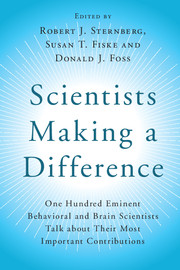 Scientists Making a Difference
Scientists Making a Difference Book contents
- Frontmatter
- Contents
- List of Contributors
- Foreword: Making a Creative Difference = Person × Environment
- Preface
- Part I Introduction
- Part II Biological Bases of Psychology: Genes, Brain, and Beyond
- Part III Cognition: Getting Information from the World and Dealing with It
- Section A Attention and Perception
- Section B Learning and Memory
- 23 Human Memory: A Proposed System and Its Control Processes
- 24 Working Memory
- 25 Emotionally Colored Cognition
- 26 Levels of Processing in Human Memory
- 27 Falling Down the Duck/Rabbit Hole
- 28 Memory Matters
- 29 What Do You Know and How Do You Know It? It's All in Your Connections
- 30 Serendipity in Research: Origins of the DRM False Memory Paradigm
- 31 Memory: Beyond Remembering
- 32 Episodic Memory
- 33 What We Learn Depends on What We Are Remembering
- Section C Complex Processes
- Part IV Development: How We Change Over Time
- Part V Motivation and Emotion: How We Feel and What We Do
- Part VI Social and Personality Processes: Who We Are and How We Interact
- Part VII Clinical and Health Psychology: Making Lives Better
- Part VIII Conclusion
- Afterword: Doing Psychology 24×7 and Why It Matters
- Index
- References
31 - Memory: Beyond Remembering
from Section B - Learning and Memory
Published online by Cambridge University Press: 05 August 2016
- Frontmatter
- Contents
- List of Contributors
- Foreword: Making a Creative Difference = Person × Environment
- Preface
- Part I Introduction
- Part II Biological Bases of Psychology: Genes, Brain, and Beyond
- Part III Cognition: Getting Information from the World and Dealing with It
- Section A Attention and Perception
- Section B Learning and Memory
- 23 Human Memory: A Proposed System and Its Control Processes
- 24 Working Memory
- 25 Emotionally Colored Cognition
- 26 Levels of Processing in Human Memory
- 27 Falling Down the Duck/Rabbit Hole
- 28 Memory Matters
- 29 What Do You Know and How Do You Know It? It's All in Your Connections
- 30 Serendipity in Research: Origins of the DRM False Memory Paradigm
- 31 Memory: Beyond Remembering
- 32 Episodic Memory
- 33 What We Learn Depends on What We Are Remembering
- Section C Complex Processes
- Part IV Development: How We Change Over Time
- Part V Motivation and Emotion: How We Feel and What We Do
- Part VI Social and Personality Processes: Who We Are and How We Interact
- Part VII Clinical and Health Psychology: Making Lives Better
- Part VIII Conclusion
- Afterword: Doing Psychology 24×7 and Why It Matters
- Index
- References
Summary
When I completed my undergraduate studies as a psychology major at the University of North Carolina at Chapel Hill in May 1974, I knew that I wanted to continue in the field, but I didn't know exactly how. After graduation, I worked as a research assistant in the laboratory of Herbert Crovitz, a cognitive psychologist at Duke University. There I tested brain-damaged amnesic patients, whose dramatic memory loss sparked my interest in the workings of human memory. I went on to graduate school at the University of Toronto and studied with Endel Tulving, a leading memory researcher. At Toronto I learned how to conduct experiments that probed individuals’ abilities to remember past experiences.
It may therefore seem odd when I say that I think that my most important scientific contribution has been to highlight this point: Much of what is most interesting and significant about memory either does not involve, or even goes beyond, simply remembering past experiences. I think that this is an important contribution because it has helped to expand our conception of what memory is and how it influences cognitive functioning. I've made contributions to two areas of research that highlight this point: (1) implicit memory, and (2) imagining future experiences.
Implicit Memory
In the standard laboratory procedure for investigating human memory, researchers show participants to-be-remembered information, such as words or pictures, and later give a test that requires them to recall or recognize the previously studied information. During the early 1980s, however, memory researchers began taking a different approach. They tested participants with tasks that did not require them to try to remember previously studied materials, tasks such as identifying a briefly flashed picture or completing a word stem (e.g., MOT__) with the first word that comes to mind. Numerous experiments, including several by my colleagues and me, showed that exposure to an item in a study list increased the likelihood of subsequently identifying or producing that item on a later test (e.g., participants were more likely to complete GAR__ with GARDEN when GARDEN appeared on the study list than when it did not). We and other researchers referred to this phenomenon as priming. Importantly, priming seemed to behave quite differently from standard measures of memory.
- Type
- Chapter
- Information
- Scientists Making a DifferenceOne Hundred Eminent Behavioral and Brain Scientists Talk about Their Most Important Contributions, pp. 148 - 151Publisher: Cambridge University PressPrint publication year: 2016
